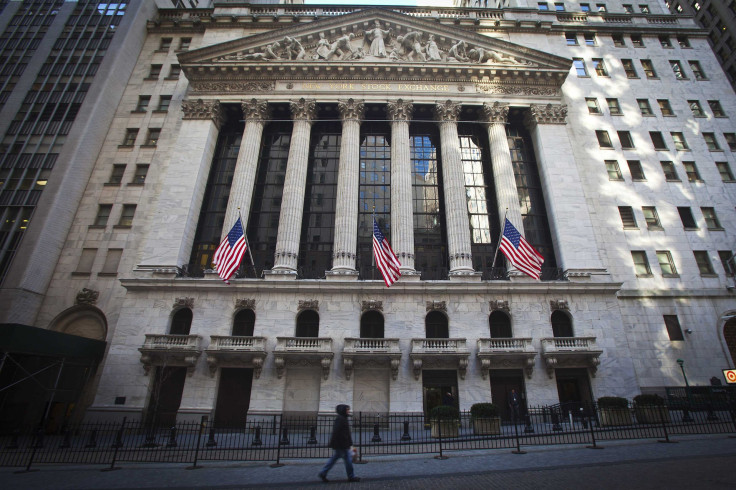Wall Street's Week Ahead: Dow Jones Industrial Average Wavers After Syriza Party Wins Greek Elections

U.S. stocks wavered Monday, with the Dow Jones Industrial Average dropping as much as 100 points in morning trading, after the Greek election of the anti-austerity party on Sunday ignited concerns over the future of the euro zone. The euro briefly tumbled as low as $1.10 on Monday, the lowest level against the dollar in more than 11 years, but edged up more than 0.4 percent higher in afternoon trading to $1.13.
UPDATED: 4 p.m. EST
Monday, the Dow, which measures the share prices of 30 large industrial companies, rebounded after falling more than 100 points in morning trading and added 6.10 points, or 0.03 percent, to close at 17,678.70; the S&P 500 stock index added 5.24 points, or 0.26 percent, to end at 2,057.06. The Nasdaq Composite gained 13.88 points, or 0.29 percent, to finish at 4,771.76.
Greek Election Fears
Global stock markets in Asia and Europe were jittery after Greece’s far-left Syriza party won 149 out of 300 seats in Parliament. Alexis Tsipras, the Syriza party’s leader, is opposed to the austerity measures that were part of Greece's financial bailout agreed with international lenders. The party led a revolt against the budget cuts and other austerity measures demanded by the “troika”---the European Commission, European Central Bank and International Monetary Fund.
Tsipras agreed to form a coalition government with the small, right-wing Independent Greeks party and said he would try to renegotiate Greece's debt agreements, the $270 billion bailout package that has allowed Greece to avoid bankruptcy.
“As the euro’s weakness continues to help exporters and the implementation of QE (quantitative easing) perhaps drives the currency or businesses’ borrowing costs down further, confidence and growth might continue to rise. Offsetting that, though, fears about Greece seem set to escalate as the new government tries to renegotiate its financial obligations to Germany and others and the threat of euro-zone exit lingers,” London-based Capital Economics, said in a research note to clients Monday.
Federal Reserve Policy Meeting
Economists will get a glimpse into the overall health of the U.S. economy as the Federal Reserve kicks off its first two-day policy meeting of the year Tuesday. Most economists expect the central bank to hike interest rates in mid-2015, but if falling oil prices have a negative effect on an improving U.S. economy, weighing on inflation and wage growth, the Fed could pause before raising rates.
The Fed warned earlier this month in its “Beige Book,” a report the central bank publishes eight times a year, that plunging oil prices since June are beginning to show harmful effects in U.S. regions that are dependent upon the energy industry, causing oil firms to report layoffs and hiring freezes.
“Outlooks for the first half of 2015 are very uncertain and significantly weaker than in the prior reporting period, with firms expecting anywhere from a 15 percent to 40 percent decline in demand for their services,” the Federal Reserve said in the report on Jan. 14.
Officials said in the Beige Book that they see the economy moving at a “modest to moderate” pace, unchanged from the previous Beige Book issued on Dec. 3, while consumer spending remained at a “slight to moderate” pace.
The Federal Open Market Committee will release a statement Wednesday at 2 p.m. EST following the Fed's two-day meeting.
U.S. Economy Fourth-Quarter Report
On Friday, the Commerce Department is scheduled to release fourth-quarter and full-year 2014 gross domestic product figures after the U.S. economy surprised economists and grew at its strongest pace in 11 years in the third quarter. The upward revision in the previous quarter was mainly due to faster consumption growth. Real personal consumption expenditures, or price changes in consumer goods and services, jumped 3.2 percent in the third quarter, compared with an increase of 2.5 percent in the second quarter.
U.S. gross domestic product, the broadest measure of goods and services produced across the economy, grew at a seasonally adjusted annual rate of 5 percent in the third quarter, compared with an increase of 4.6 percent in the second quarter, after decreasing 2.1 percent in the first.
Economists expect the U.S. economy to expand 3.1 percent annual pace in the fourth quarter, according to analysts polled by Reuters.
Here's the latest economic calendar for the week of Jan. 26. All listed times are EST.
Monday, Jan. 26
No major U.S. economic data scheduled.
Tuesday, Jan. 27
8:30 a.m. -- Durable goods orders (Dec.)
9 a.m. -- Case-Shiller home prices (Nov.)
10 a.m. -- Consumer confidence index (Jan.)
10 a.m. -- New home sales (Dec.)
Non-U.S.:
U.K. -- Gross Domestic Product (Q4)
Wednesday, Jan. 28
2 p.m. -- FOMC announcement
Non-U.S.:
New Zealand -- New Zealand Reserve Bank Monetary Policy Statement; Interest Rate Decision
Australia -- Consumer Price Index (Q4)
Thursday, Jan. 29
8:30 a.m. -- Weekly jobless claims
10 a.m. -- Pending home sales (Dec.)
Non-U.S.:
Germany -- Unemployment Rate (Jan.)
Japan -- National Consumer Price Index (YoY)
Friday, Jan. 30
8:30 a.m. – U.S. gross domestic product (Q4)
8:30 a.m. – Employment cost index (Q4)
9:45 a.m. -- Chicago PMI (Jan.)
9:55 a.m. -- Consumer sentiment index (Jan.)
Non-U.S.:
Europe -- Consumer Price Index (YoY) (Jan.)
© Copyright IBTimes 2024. All rights reserved.












